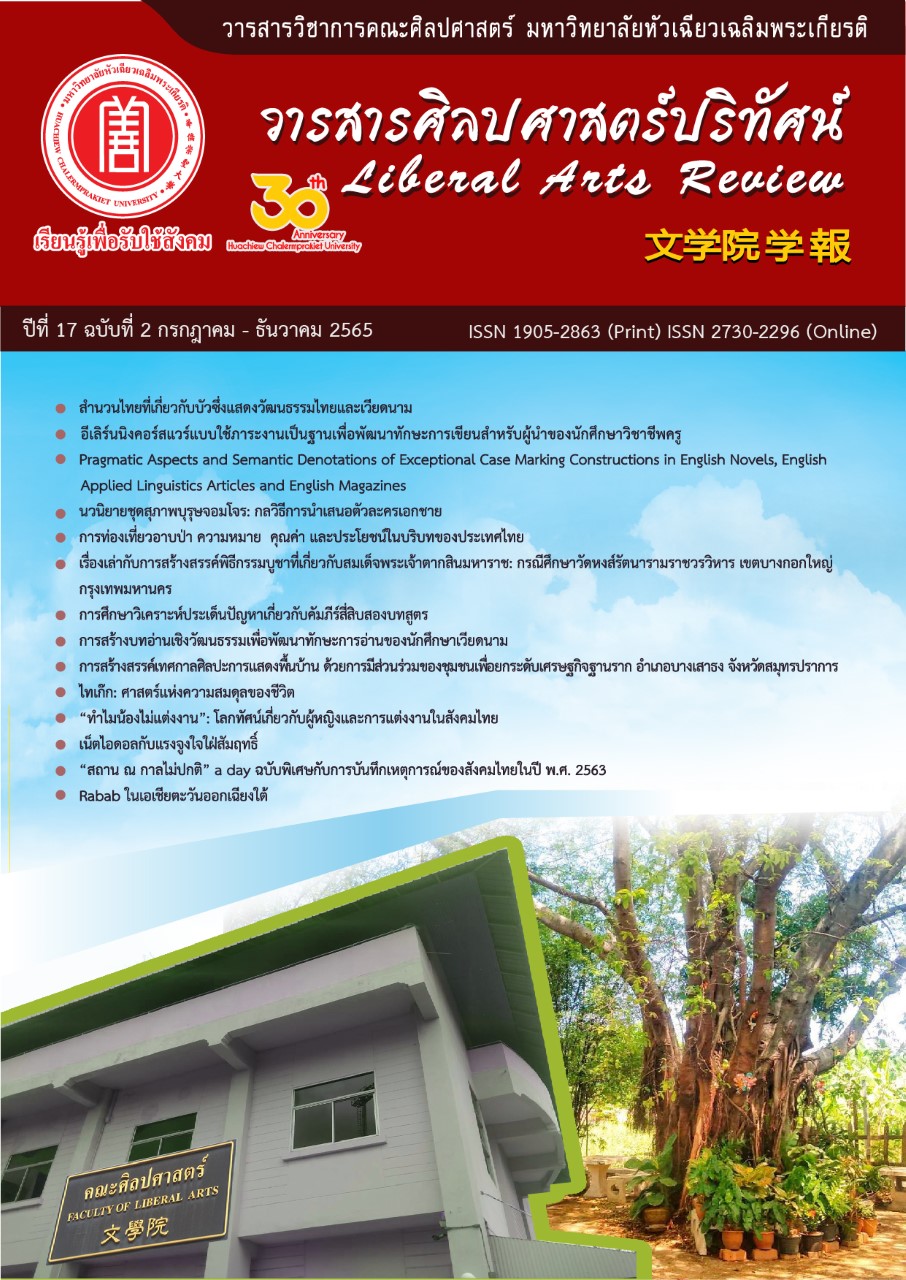The Thai Idioms about the Lotus showing how Thai Culture relates to Vietnamese Culture
DOI:
https://doi.org/10.14456/lar.2022.11Keywords:
Thai idioms about lotus, Culture, Thai, VietnameseAbstract
This research article aimed to study Thai culture as shown in Thai idioms about the lotus in connection with Vietnamese culture. The result showed that four Thai idioms about the lotus, which were ‘bua mâi chám náam mâi kùn’ (Neither let a lotus get bruised nor let water get turbid), ‘det dō̜kmai wai khūa det būa mai wai yai’ (Plucking a flower and lotus without keeping its stems), ‘hen kongčhak pen dō̜kbūa’ (Mistaking blades for a lotus), and ‘mǣsāibūa tǣngtūa khāng’ (Waiting Lady), reflected aspects of Thai culture and lifestyle, which were food culture, behavior and relationship of people in the society, belief in Buddhism, and language. Thai people have been very observant about lotuses in their daily lives, such as planting lotuses in the pond, plucking lotuses and their gossamer, and food preparation from lotus stems. All of these have brought to be created as idioms to portray values, beliefs, traditions, and attitudes of Thai society. Therefore, the lotus has associated with the Thai lifestyle, which has been a common characteristic with Vietnamese people who have valued the lotus as well, as has showed through food, religion and the analogy of lotus and the relationship of people in society. Therefore, Vietnamese students who studied Thai idioms about the lotus could understand Thai culture more clearly by using the lotus as a medium.
References
กรมส่งเสริมวัฒนธรรม. (2558). อัตลักษณ์อาหารไทย 4 ภาค = The identity of Thai cuisine in the 4 regions. กรุงเทพมหานคร: กระทรวงวัฒนธรรม.
กระทรวงศึกษาธิการ. (2545). สำนวนไทย. กรุงเทพมหานคร: ศูนย์พัฒนาหนังสือ กรมวิชาการ กระทรวงศึกษาธิการ.
กระทรวงศึกษาธิการ. (2552). หนังสืออุเทศภาษาไทย ภาษาไทย น่าศึกษาหาคำตอบ. กรุงเทพมหานคร: สกสค. ลาดพร้าว.
กฤษฎา มีสกุล. โครงการอนุรักษ์พันธุกรรมพืชอันเนื่องมาจากพระราชดำริฯ สมเด็จพระเทพรัตนราชสุดาฯ สยามบรมราชกุมารี มทร.ธัญบุรี [อินเทอร์เน็ต]. ปทุมธานี: มหาวิทยาลัยเทคโนโลยีราชมงคล; 2562 [เข้าถึงเมื่อ 23 มกราคม 2565]. ค้นคืนจาก http://www.rspg.rmutt.ac.th/?p=4188.
จารุวรรณ นพพรรค์. (2525). ทฤษฎีอาหาร 1 = อาหารประจำภาค 4 ภาค. กรุงเทพมหานคร: โอเดียนสโตร์.
ดนัย เมธิตานนท์. (2548). บ่อเกิดสำนวนไทย. กรุงเทพมหานคร: มิติใหม่.
ดินาร์ บุญธรรม. (2557). วัฒนธรรมดอกไม้. กรุงเทพมหานคร: สถาบันไทยศึกษา จุฬาลงกรณ์มหาวิทยาลัย.
ธัญนันท์ วีระกุล. (2551). ไม้มงคล (พิมพ์ครั้งที่ 3). กรุงเทพมหานคร: บ้านและสวน.
พระชลญาณมุนี, และสรวิชญ์ วงษ์สอาด. (2563). พระพุทธศาสนากับความเชื่อ. วารสาร มหาวิทยาลัยมหาจุฬาลงกรณราชวิทยาลัย บาฬีศึกษาพุทธโฆสปริทรรศน์, 6(2), 99-115.
พันธิตร์ มะลิสุวรรณ, และ ดนุชณัฐ ติณเวส. (2547). อาหารจากดอกไม้ คุณค่าคู่ความงาม. สมุนไพรเพื่อสุขภาพ, 3(40), 63-73.
มหาวิทยาลัยสุโยทัยธรรมธิราช. (2555). การสื่อสารระหว่างวัฒนธรรม. กรุงเทพมหานคร: อรุณการพิมพ์.
ราชบัณฑิตยสภา. (2561). ภาษิต คำพังเพย สำนวนไทย (พิมพ์ครั้งที่ 17). กรุงเทพมหานคร: สำนักงานราชบัณฑิตยสภา.
ลดาวัลย์ อินคง. (2563). เสน่ห์ อาหารไทยโบราณ หาทานยากในปัจจุบัน. ค้นคืนจาก https://www.baanlaesuan.com/54636 /thai-food.
วรเดช อมรวรพิพัฒน์, และพิเชฏฐ์ กาลามเกษตร์. (2560). วิถีชีวิต 5 ศาสนิกในประเทศไทย : พุทธ อิสลาม คริสต์ พราหมณ์-ฮินดู ซิกข์. กรุงเทพมหานคร: กรมการศาสนา.
วรวรรณ คงมานุสรณ์. (2549). รู้ถ้วนสำนวนไทย. กรุงเทพมหานคร: อักษรเจริญทัศน์.
วราภรณ์ คีรีพัฒน์. (2546). อาหารเพื่อสุขภาพ. รูสมิแล, 24(3), 49-58.
วาณิช จรุงกิจอนันต์. (2528). ถกสำนวนไทย เล่ม 2. กรุงเทพมหานคร: บูรพาสาส์น.
ศูนย์เทคโนโลยีทางการศึกษา. (2560). ภาษาไทยใช้ให้ถูก. ค้นคืนจาก http://www.moeradiothai.net/web/news_etc/detail/160.
สง่า กาญจนาคพันธุ์. (2538). สำนวนไทย. กรุงเทพมหานคร: สมาคมส่งเสริมเทคโนโลยี่ ไทย-ญี่ปุ่น.
สำนักงานสถิติแห่งชาติ. (2561). สำนักงานสถิติฯ เผยผลสำรวจสภาวะทางสังคม วัฒนธรรม และสุขภาพจิต ปี 2561. ค้นคืนจาก http://www.nso.go.th/sites/2014/Pages/News/2561/N21-09-61-1.aspx.
สิรจิตต์ เดชอมรชัย. (2556). การสอนภาษาฝรั่งเศษในฐานะภาษาต่างประเทศ : แนวคิดและวิธีการ. กรุงเทพมหานคร: จุฬาลงกรณ์มหาวิทยาลัย.
สุวัฒน์ อัศวไชยชาญ. (2553). บัวไทย. กรุงเทพมหานคร: ปลาตะเพียน.
Anh, L. (2020). National Assembly delegate Tran Thi Quoc Khanh questioned the Prime Minister about Vietnam's national flower. Retrieved from https://quochoi.vn/hoatdongdbqh/pages/tin-hoat-dong-dai-bieu.aspx?ItemID=45672.
Cao, H. T. (2019). Buddhist thought in Vietnamese fairy tales. Retrieved from https://phatgiao.org.vn/tu-tuong-phat-giao-trong-truyen-co-tich-viet-nam-d33760.html.
Chu, X. D., Luong, V. D., & Phuong, T. (1993). Vietnamese Proverbs. Ha Noi: Ha Noi Science and Technology.
Dai Doan Ket Newspaper. (2021). Water lily with fish sauce. Retrieved from http://daidoanket.vn/bong-sung-mam-kho-557695.html.
Hoang, P. (2007). Vietnamese Dictionary. Da Nang: Vietlex.
Khai, T. M. L., & Mahavarakorn, S. (2019). Thai Language Learning and Teaching of the Vietnamese Students in Cross-Cultural Communication Contexts. In International Symposium on Education, Psychology and Social Sciences 2019 (pp. 40-46). Tokyo: ISEPSS.
Mai, V. H. (2013). "Regret a little old companionship" Is Kieu missing and thinking about Kim Trong [special issues]. Song Huong Journal, 13(8). Retrieved from http://tapchisonghuong.com.vn/tin-tuc/p0/c7/n11851/Tiec-thay-chut-nghia-cu-cang-phai-chang-la-Kieu-nho-va-nghi-ve-Kim-Trong.html.
Nguyen, P. C. (2000). Lotus symbol in Vietnamese culture. Van hoa dan gian, 72(9), 53-61.
Pham, D. D., & Tran, T. T. L. (2001). Culture of Southeast Asia. Ho Chi Minh: Education.
Phuc, T. L. N., & S Mahavarakorn, S., (2020). Culture and ways of life in Thai and Vietnamese Street Food. Institute of Culture and Arts Journal, 22(1), 85-97.
Mahavarakorn, S., Pornamphaisaku, N., Yenbutra, P. (2018). Constructing culture-based reading materials to improve reading skill of the Vitnamese students. Bangkok: Srinakharinthawirot.
Thanh, N. (2008). Lotus flower in Vietnamese food culture. Retrieved from https://giacngo.vn/hoa-sen-trong-van-hoa-am-thuc-viet-nam-post2126.html.
The United States Embassy and Consulate in Vietnam. (2018). International Religious Freedom Report – Vietnam 2018. Retrieved from https://vn.usembassy.gov/vi/irfreport2018.
Them, N. T. (1999). The basis of Vietnamese cultural. Ha Noi: Education publishing house.
Trang, T. T. N. (2017). Type of Cinderella story in Vietnam and some Asian countries. In Proceedings of the International Conference on Vietnamese Studies (pp. 1111-1120). Ho Chi Minh: Ho Chi Minh City National University.
Van, T. (2021). Discover features in the food culture of lotus. Retrieved from https://golfviet.vn/kham-pha-net-dac-trung-trong-van-hoa-am-thuc-cua-hoa-sen-d5665.html.
Vietnam Television. (2018). Lotus in Vietnamese culture. Retrieved from https://www.youtube.com/watch?v=6kKkw3ad8Sg&t=98s.
Downloads
Published
How to Cite
Issue
Section
License
Copyright (c) 2022 Liberal Arts Review

This work is licensed under a Creative Commons Attribution-NonCommercial-NoDerivatives 4.0 International License.
บทความที่ได้รับการตีพิมพ์เป็นลิขสิทธิ์ของวารสารศิลปศาสตร์วิชาการและวิจัย
ข้อความที่ปรากฏในบทความแต่ละเรื่องในวารสารวิชาการเล่มนี้เป็นความคิดเห็นส่วนตัวของผู้เขียนแต่ละท่านไม่เกี่ยวข้องกับมหาวิทยาลัยหัวเฉียวเฉลิมพระเกียรติ และคณาจารย์ท่านอื่นๆ ในมหาวิทยาลัยฯ แต่อย่างใด ความรับผิดชอบองค์ประกอบทั้งหมดของบทความแต่ละเรื่องเป็นของผู้เขียนแต่ละท่าน หากมีความผิดพลาดใดๆ ผู้เขียนแต่ละท่านจะรับผิดชอบบทความของตนเองแต่ผู้เดียว




